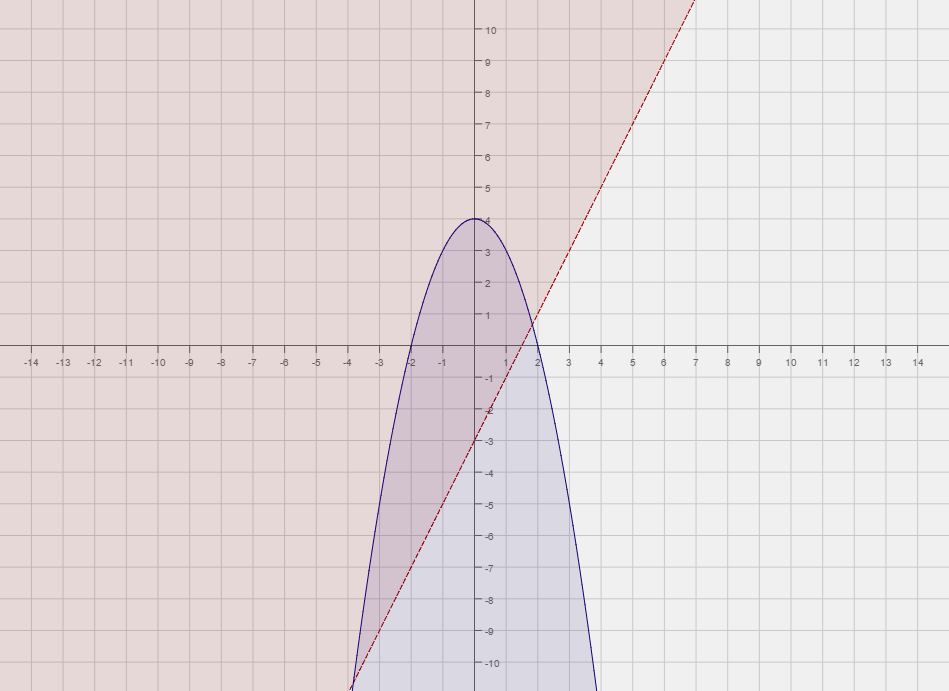Difference between revisions of "004 Sample Final A, Problem 4"
Jump to navigation
Jump to search
| Line 5: | Line 5: | ||
! Step 1: | ! Step 1: | ||
|- | |- | ||
| − | |First we replace the inequalities with equality. So <math>y = | + | |First we replace the inequalities with equality. So <math>y = 2x - 3</math>, and <math>y = 4 - x^2</math>. |
|- | |- | ||
|Now we graph both functions. | |Now we graph both functions. | ||
| Line 19: | Line 19: | ||
|point satisfies the inequality or not. For both equations we will pick the origin. | |point satisfies the inequality or not. For both equations we will pick the origin. | ||
|- | |- | ||
| − | |<math>y | + | |<math>y > 2x - 3:</math> Plugging in the origin we get, <math> 0 > 2(0) - 3 = -3 </math>. Since the inequality is false, we shade the side of |
|- | |- | ||
| − | |<math>y | + | |<math>y = 2x - 3</math> that does not include the origin. We make the graph of <math>y < \vert x\vert + 1</math> dashed, since the inequality is strict. |
|- | |- | ||
| − | |<math>x^2 | + | |<math>y \le 4 - x^2:</math> Plugging in the origin we get <math>0 \le 4 - (0)^2 = 4</math>. Since this inequality is true, we shade the side of <math>y = 4 - x^2</math> that includes the origin. Here we make the graph of <math> y = 4 - x^2 </math> solid since the inequality sign is <math>\le</math> |
| − | |||
| − | |||
|} | |} | ||
| Line 31: | Line 29: | ||
! Final Answer: | ! Final Answer: | ||
|- | |- | ||
| − | |The final solution is the portion of the graph that below <math>y = | + | |The final solution is the portion of the graph that below <math>y = 4 - x^2</math> and above <math> y = 2x - 3</math> |
|- | |- | ||
|The region we are referring to is shaded both blue and red. | |The region we are referring to is shaded both blue and red. | ||
|- | |- | ||
| − | |[[File: | + | |[[File:4_Sample_Final_4.png]] |
|} | |} | ||
[[004 Sample Final A|<u>'''Return to Sample Exam</u>''']] | [[004 Sample Final A|<u>'''Return to Sample Exam</u>''']] | ||
Latest revision as of 09:08, 2 June 2015
Graph the system of inequalities. Solution:
| Step 1: |
|---|
| First we replace the inequalities with equality. So , and . |
| Now we graph both functions. |
| Step 2: |
|---|
| Now that we have graphed both functions we need to know which region to shade with respect to each graph. |
| To do this we pick a point an equation and a point not on the graph of that equation. We then check if the |
| point satisfies the inequality or not. For both equations we will pick the origin. |
| Plugging in the origin we get, . Since the inequality is false, we shade the side of |
| that does not include the origin. We make the graph of dashed, since the inequality is strict. |
| Plugging in the origin we get . Since this inequality is true, we shade the side of that includes the origin. Here we make the graph of solid since the inequality sign is |
| Final Answer: |
|---|
| The final solution is the portion of the graph that below and above |
| The region we are referring to is shaded both blue and red. |

|








